#Sustainability in Retail
Explore tagged Tumblr posts
Text
Changing Landscape of European Retail
Written By: Jagriti Shahi
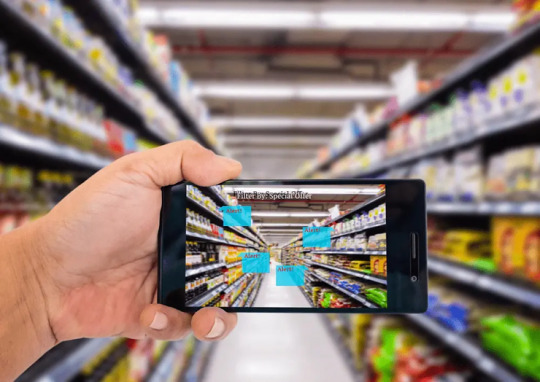
Figure: Growth of retail in Europe
The retail industry in Europe has undergone significant transformations in recent years, driven by changing consumer preferences, technological advancements, and global economic shifts. From traditional brick-and-mortar stores to e-commerce giants, European retail has seen a remarkable evolution. In this article, we will explore the key trends shaping the changing landscape of European retail and how businesses are adapting to stay competitive in this dynamic environment. The retail sector in Europe is the largest in the world, with a turnover of over €2 trillion in 2021. The sector employs over 20 million people and accounts for about 10% of the EU's GDP. The retail sector in Europe is highly fragmented, with a large number of small and medium-sized enterprises (SMEs). However, there are also a number of large multinational retailers operating in the market, such as Carrefour, Tesco, and IKEA.
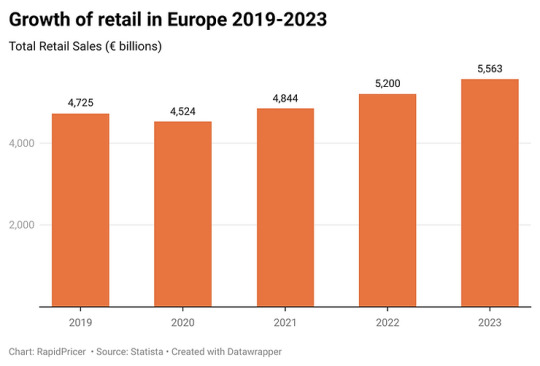
Figure: Growth of retail in Europe
The retail sector in Europe is facing a number of challenges, including the rise of e-commerce, the changing demographics of consumers, and the increasing adoption of new technologies. The rise of e-commerce is one of the most significant challenges facing the retail sector in Europe. In 2021, online retail sales in Europe reached €768 billion, accounting for 16.1% of total retail sales. This growth is being driven by a number of factors, including the increasing availability of high-speed internet, the growing popularity of mobile shopping, and the convenience of online shopping.
Traditional brick-and-mortar retailers are struggling to compete with the convenience and lower prices of online retailers. In order to survive, traditional retailers are investing in their online presence and offering omnichannel experiences that allow customers to shop online and in-store. The demographics of European consumers are also changing, which is having an impact on the retail landscape. The population is aging, with more people over the age of 65. This group is increasingly active and affluent, and they are looking for different products and services than younger consumers. They are also more likely to shop online.
Another demographic trend is the increasing diversity of the European population. This is leading to a demand for more ethnic food and clothing stores. Retailers are also adapting their marketing and advertising to reach these new customer groups.
New technologies are also having a major impact on the retail landscape. The use of artificial intelligence (AI), augmented reality (AR), and virtual reality (VR) is growing, and these technologies are being used to improve the customer experience in a number of ways. For example, AI can be used to personalize recommendations, AR can be used to try on clothes virtually, and VR can be used to create immersive shopping experiences. The adoption of new technologies is also creating new opportunities for retailers. For example, retailers can use data analytics to track customer behavior and improve their marketing and product offerings. They can also use social media to connect with customers and build relationships.
The future of European retail is uncertain, but it is clear that the industry is undergoing a major transformation. The rise of e-commerce, the changing demographics of consumers, and the increasing adoption of new technologies are all having a major impact on the way people shop. Retailers that are able to adapt to these changes will be the ones that are successful in the future.
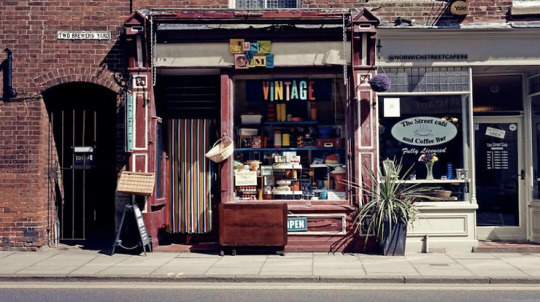
Figure: Brick-and-Mortar stores
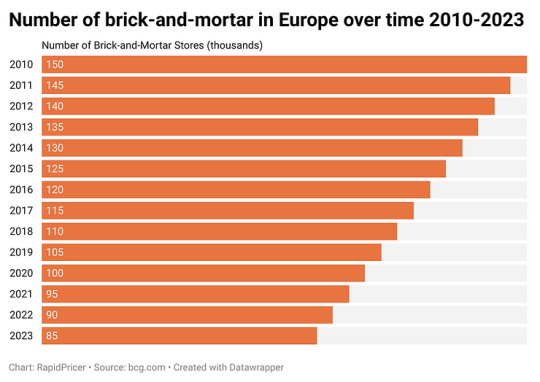
Figure: Number of brick-and-mortar in Europe over time
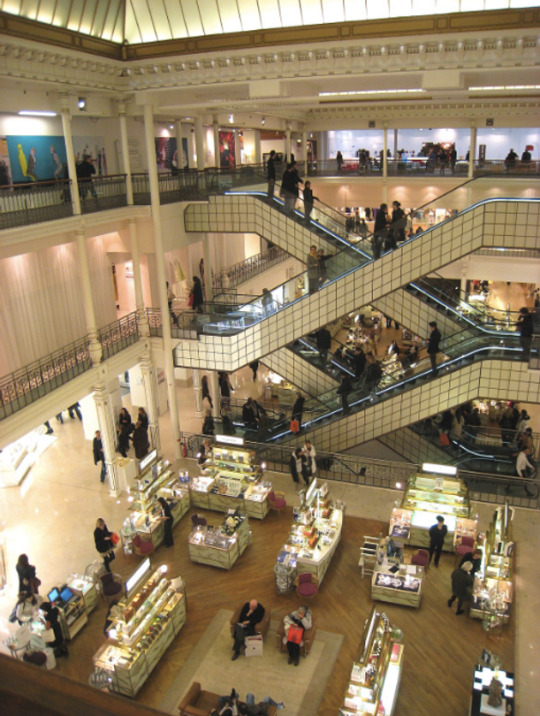
Figure: Department stores
Department stores: Department stores are large stores that sell a variety of products, such as clothing, home goods, and electronics. Some of the most famous department stores in Europe include Galeries Lafayette in Paris, Selfridges in London, and El Corte Inglés in Madrid.

Figure: Independent retailers
Independent retailers: Independent retailers are small, privately owned businesses that sell a variety of products. These retailers often have a strong local presence and offer a unique shopping experience.
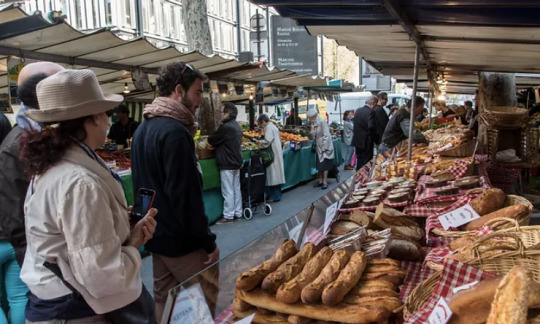
Figure: Markets
Markets: Markets are a great place to find fresh produce, meats, cheeses, and other local products. Many European cities have traditional markets that have been operating for centuries.
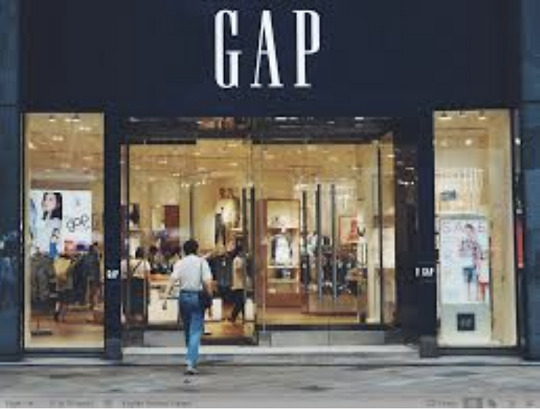
Figure: Outlet
Outlet malls: Outlet malls are a great place to find discounted name-brand clothing, shoes, and accessories. These malls are often located in tourist destinations.
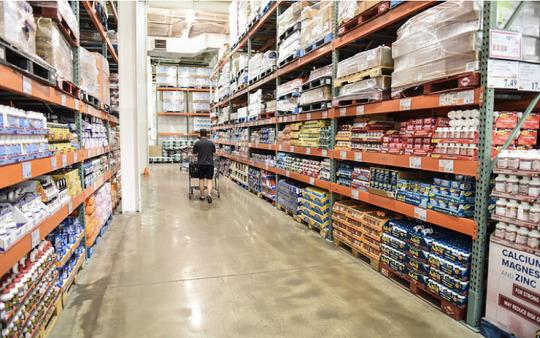
Figure: Warehouse clubs
Warehouse clubs: Warehouse clubs are membership-only stores that sell a variety of products in bulk. These clubs are a great place to find discounts on groceries, household goods, and other items.
Traditional retail is still a major part of the retail landscape in Europe, and it is likely to remain so for the foreseeable future. These stores offer a unique shopping experience that cannot be replicated online. In addition, many traditional retailers are adapting to the changing retail landscape by investing in their online presence and offering omnichannel shopping experiences.
The European Retail Landscape
Europe boasts a diverse and rich retail heritage, with traditional shops, boutiques, and markets dating back centuries. These establishments have played a significant role in local economies, offering consumers a wide range of goods and personalized shopping experiences.
Challenges in the Digital Age: Traditional retail in Europe has felt the impact of the digital age. The rapid growth of e-commerce giants like Amazon, along with the convenience of online shopping, has led to a decline in foot traffic at brick-and-mortar stores. Consumers now have access to a vast array of products with the click of a button, making it essential for traditional retailers to adapt.
The Omnichannel Approach: Many traditional European retailers are responding to the digital challenge by adopting an omnichannel approach. This strategy combines physical stores with an online presence, offering consumers a seamless shopping experience. Retailers are investing in e-commerce websites, mobile apps, and in-store technology to bridge the gap between offline and online shopping.
Customer Experience and Personalization: One advantage traditional retailers have over e-commerce is the ability to provide a unique and personalized customer experience. Many European consumers still value the tactile, sensory experience of shopping in a physical store. Traditional retailers are focusing on creating welcoming and interactive environments, offering personalized service, and curating their product selections to cater to local tastes.
Sustainability and Localism: In response to consumer demand for sustainability and ethical shopping, traditional European retailers are emphasizing their commitment to local sourcing and environmentally friendly practices. Some are rediscovering the benefits of locally-produced goods, promoting them as eco-friendly alternatives to mass-produced items. This aligns with the rising trend of supporting local businesses and reducing the carbon footprint associated with global supply chains.
Cultural and Historical Significance: Traditional retail establishments often hold cultural and historical significance in European communities. Many have been in operation for generations, serving as cornerstones of local culture. These stores are cherished by residents and tourists alike, and efforts are made to preserve their historical authenticity while integrating modern retail practices.
Government Support: Some European governments recognize the importance of preserving traditional retail and are offering support through grants, subsidies, and regulatory measures. These initiatives aim to bolster traditional retail against the encroachment of e-commerce and maintain the vibrancy of city centers.
Conclusion
Traditional retail in Europe is at a crossroads. While it faces challenges from the digital age and changing consumer preferences, it also has unique advantages rooted in history, culture, and personalized shopping experiences. To thrive in today's retail landscape, traditional retailers must embrace technology, adopt an omnichannel approach, focus on customer experience, and align with sustainability and localism trends. In doing so, traditional European retail can not only survive but also continue to offer consumers a distinctive and cherished shopping experience that reflects the rich tapestry of Europe's retail heritage. By adapting to the evolving market while preserving their unique qualities, traditional retailers can continue to play a vital role in the continent's commercial landscape.
The changing demographics of consumers
The demographics of European consumers are also changing, which is having an impact on the retail landscape. The population is aging, with more people over the age of 65. This group is increasingly active and affluent, and they are looking for different products and services than younger consumers. They are also more likely to shop online.
Another demographic trend is the increasing diversity of the European population. This is leading to a demand for more ethnic food and clothing stores. Retailers are also adapting their marketing and advertising to reach these new customer groups.
Here are some specific examples of how the changing demographics of consumers are impacting the retail industry in Europe:
The aging population is leading to a demand for more accessible and convenient shopping options. This is driving the growth of online grocery delivery and click-and-collect services.
The increasing diversity of the population is leading to a demand for more ethnic food and clothing stores. This is also leading to a demand for products and services that cater to the needs of diverse cultures, such as halal food and bilingual customer service.
The rise of the digital native is leading to a demand for more personalized and engaging shopping experiences. This is driving the growth of mobile commerce and augmented reality (AR) shopping.
The changing role of women is leading to a demand for more flexible shopping hours and options for online shopping. This is also leading to a demand for more products and services that are designed for women, such as maternity clothing and baby products.
The growing importance of sustainability is leading to a demand for more sustainable products and services. This is driving the growth of organic food, fair trade clothing, and recycled packaging.
The increasing adoption of new technologies
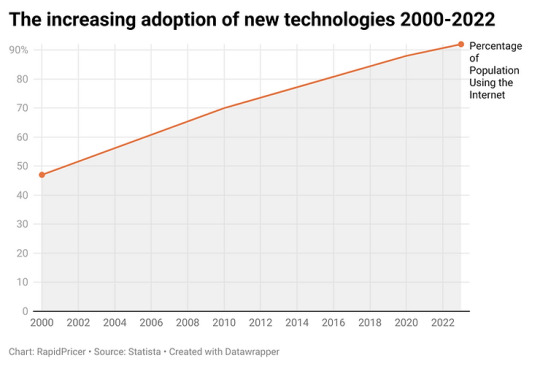
Figure: The increasing adoption of new technologies
As you can see, the percentage of people in Europe using the internet has been increasing steadily over the past two decades. This is due to a number of factors, including the increasing availability of high-speed internet, the falling cost of computers and smartphones, and the growing popularity of online services.
The increasing adoption of new technologies is having a major impact on the retail industry in Europe. Here are some of the key technologies that are being adopted by retailers in Europe:
Artificial intelligence (AI): AI is being used to improve a variety of tasks in the retail industry, such as customer service, inventory management, and fraud detection. For example, AI can be used to analyze customer data to personalize recommendations, or to predict which products are likely to be in high demand.
Augmented reality (AR): AR is being used to create immersive shopping experiences that allow customers to try on clothes virtually or see how furniture would look in their home. For example, IKEA has an AR app that allows customers to see how its furniture would look in their living room.
Virtual reality (VR): VR is being used to create even more immersive shopping experiences that allow customers to virtually visit stores and try on products. For example, Amazon has a VR store that allows customers to browse its products and make purchases.
Internet of Things (IoT): IoT is being used to connect devices and collect data about customer behavior. This data can be used to improve a variety of tasks, such as inventory management and customer service. For example, retailers can use IoT sensors to track the movement of products in stores and to identify when products are running low.
Blockchain: Blockchain is being used to create secure and transparent supply chains. This can help retailers to ensure the authenticity of their products and to track their products from the source to the customer. For example, Walmart is using blockchain to track the supply chain of its food products.
These are just some of the key technologies that are being adopted by retailers in Europe. The adoption of these technologies is helping retailers to improve their efficiency, personalize the customer experience, and create a more sustainable supply chain.
E-Commerce Dominance
One of the most profound shifts in European retail has been the rise of e-commerce. Consumers now have the convenience of shopping online from the comfort of their homes, and this trend has been accelerated by the COVID-19 pandemic. Major players like Amazon, Alibaba, and local champions such as Zalando and ASOS have expanded their reach across Europe, reshaping consumer behavior and expectations. Retailers have had to invest heavily in their online presence, enhancing websites, mobile apps, and supply chain logistics to meet the demand for digital shopping. Additionally, omnichannel strategies have become essential, allowing consumers to seamlessly switch between online and offline shopping experiences.
E-commerce dominance refers to the growing market share of online retailers over traditional brick-and-mortar stores. This trend is being driven by a number of factors, including the increasing availability of high-speed internet, the growing popularity of mobile shopping, and the convenience of online shopping. In Europe, e-commerce sales are expected to reach €768 billion in 2022, accounting for 16.1% of total retail sales. This growth is being driven by the increasing adoption of online shopping by consumers across all demographics.
There are a number of reasons why e-commerce is becoming so dominant. First, the availability of high-speed internet has made it possible for consumers to shop online quickly and easily. Second, the popularity of mobile shopping has made it possible for consumers to shop online from anywhere. Third, the convenience of online shopping is unmatched by traditional brick-and-mortar stores. Consumers can shop online 24/7, compare prices from different retailers, and have products delivered to their door. The rise of e-commerce is having a major impact on the retail industry. Traditional brick-and-mortar stores are facing increasing competition from online retailers, and many are struggling to compete. In order to survive, traditional retailers need to adapt to the changing retail landscape by investing in their online presence and offering omnichannel shopping experiences.

Figure: Share of online retail sales in Europe over time
As you can see, the share of online retail sales in Europe has been increasing steadily in recent years. This is due to the increasing popularity of online shopping, which is more convenient and offers a wider selection of products. The share of online retail sales is expected to continue to increase in the coming years. However, it is important to note that not all countries are affected equally. For example, the share of online retail sales is higher in Northern Europe than in Southern Europe. The future of online retail in Europe is bright. The growth of online shopping is being driven by a number of factors, including the increasing availability of high-speed internet, the growing popularity of smartphones and tablets, and the increasing convenience of online shopping.
Sustainability and Ethical Consumption
The European retail landscape is witnessing a significant shift towards sustainability and ethical consumption. Consumers are becoming increasingly aware of the environmental and social impact of their purchases. Retailers are responding by adopting eco-friendly practices, sourcing sustainable products, and promoting transparency in their supply chains.
Fashion brands, in particular, have made strides in sustainable fashion, with initiatives like "slow fashion" and clothing rental services gaining popularity. European consumers are favoring products that are produced responsibly and have a lower environmental footprint, and retailers are aligning their strategies with these values.
Personalization and Data Analytics
Data analytics and artificial intelligence are playing a crucial role in the transformation of European retail. Retailers are harnessing the power of big data to gain insights into consumer behavior, preferences, and shopping habits. This data-driven approach allows them to personalize marketing efforts, optimize inventory management, and enhance the overall shopping experience.
Personalized recommendations, targeted advertising, and tailored promotions are becoming the norm in the industry. Retailers are using predictive analytics to forecast trends and adjust their product offerings accordingly, ensuring they stay ahead of consumer demands.
Pop-Up Stores and Experiential Retail
While online shopping continues to grow, physical stores are not becoming obsolete. Instead, retailers are reimagining the in-store experience to attract and engage customers. Pop-up stores and experiential retail spaces are gaining popularity, offering unique and immersive experiences that cannot be replicated online.
These temporary stores allow retailers to test new products and connect with customers on a more personal level. They often incorporate interactive elements, such as virtual reality experiences or live demonstrations, to create memorable moments for shoppers.
Cross-Border Expansion
European retailers are increasingly looking beyond their home markets for growth opportunities. Cross-border expansion has become a viable strategy for many companies seeking to tap into new customer bases and diversify revenue streams. The European Union's single market has facilitated this expansion by reducing trade barriers and harmonizing regulations.
Furthermore, technology has made it easier for retailers to reach international customers through e-commerce platforms and digital marketing. As a result, many European brands are expanding their presence into neighboring countries and even outside of Europe, creating a more competitive and globalized retail landscape.
Post COVID European Retail
The retail industry in Europe is undergoing a period of change after COVID. The pandemic has accelerated the shift to online shopping, and brick-and-mortar stores are struggling to compete. Retailers are responding by adopting new technologies, such as AR and VR, and by offering more convenient shopping experiences, such as BOPIS. The industry is also focusing on sustainability, as consumers are increasingly demanding sustainable products and services.
Conclusion
The changing landscape of European retail is characterized by the rapid growth of e-commerce, a focus on sustainability and ethical consumption, data-driven personalization, experiential in-store experiences, and cross-border expansion. Retailers that adapt to these trends and embrace digital transformation are likely to thrive in this dynamic environment.
The future of European retail will continue to be shaped by evolving consumer preferences and technological innovations. To stay relevant, retailers must remain agile, customer-centric, and committed to ethical and sustainable practices. As the industry continues to evolve, it will be exciting to see how retailers innovate and compete in this ever-changing landscape.
About RapidPricer
RapidPricer helps automate pricing, promotions and assortment for retailers. The company has capabilities in retail pricing, artificial intelligence and deep learning to compute merchandising actions for real-time execution in a retail environment.
Contact info:
Website: https://www.rapidpricer.com/
LinkedIn: https://www.linkedin.com/company/rapidpricer/
Email: [email protected]
#European Retail Industry#Retail Trends in Europe#E-commerce Growth#Brick-and-Mortar Stores#Omnichannel Retailing#Digital Transformation#Consumer Behavior#Sustainability in Retail#Retail Technology#Online Marketplaces#Supply Chain Disruptions#Post-Pandemic Retail#Retail Innovation#Mobile Shopping#Data Analytics in Retail#Cross-Border Shopping#Pop-Up Stores#Customer Experience#Retail Competition#Retailer Partnerships#Retail Regulations#Future of Retail in Europe#Retail Challenges#Local vs. Global Retailers#Retail Adaptation Strategies
0 notes
Text
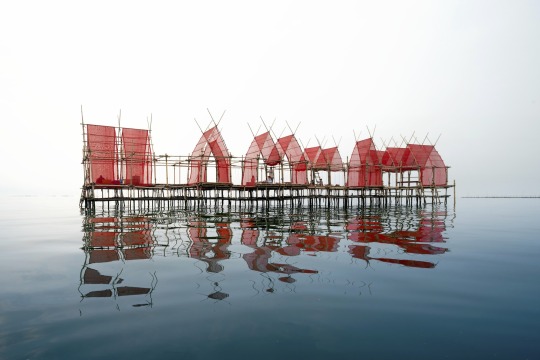









Angsila Oyster Scaffolding Pavilion, Chonburi, Thailand,
Chat Architects
#art#design#architecture#travels#bamboo#nature#seafood#foodong#restaurant#oyster#scaffolding#pavilion#chat architecture#eco-tourism#angsila#sustainability#sustainable architecture#retail#sea#thailand#chonburi#aquatic life#fisheries#angsila oyster scaffolding pavilion
240 notes
·
View notes
Text

#thrifting#thrift store#thrift shop#shopping#retail therapy#consumerism#sustainability#earth#mother earth#mother nature#community#pagan#healing#nature#self care#fashion#fashion haul#clothing#photos#not mine
144 notes
·
View notes
Text
being an underpaid, broke, worker in a thankless job hits different when you're a public servant. id love to slack off and do the bare minimum and waste my employers time but unfortunately that just results in ableism against children and not epic pwnage on capitalism. [thunks my head against the desk]
#badger rants#like massive solidarity to my retail and foodservice brothers like i definitely have it good compared to a lot of you#but also. i get bit and shit on and i make 21k after taxes which isnt sustainable in the slightest#support your local education unions#[bangs my head on the table more[#yes im doing my college work so i can get my degree and move up in my field why do you ask <- guy who wants to be doing Not That right now
2 notes
·
View notes
Text












Let's talk about "retail therapy."
I'm guilty of using it as a crutch over and over again in my life. I'm sure many of you have found yourself doing the same thing. It's an easy habit to acquire when it's part of your family's regular way of coping with things. When shopping is the only way your family can spend time together. When everyone around you sees encouraging someone to buy something as a way of communicating love and affection.
It's no wonder that holiday retail sales set a record last year. People are stressed and afraid. Enter...retail therapy.
The slides above go into my experience with it. But I'll tell you this: for all of the improvement I have made in this area, I still catch myself *almost* falling back into the habit. About two years ago, when I was still at my toxic job, I had a really horrible, humiliating day. It was the culmination of months of intensifying stress/anxiety. I had been having a lot of difficult sleeping, eating, caring for myself. On that horrible day, I just completely broke down, crying all night. I couldn't sleep because my brain was swirling with intrusive thoughts. And at one point--it was probably like 3 am--I sat up and thought "I should go buy something online to cheer myself up." I got out of bed, grabbed my glasses, and stumbled into my office. I stared blankly at my computer monitor. What could I buy to make myself feel better? I couldn't think of anything. Not even one thing.
I was sitting there, feeling confused about the whole situation, when Brenda (my cat) jumped on to my lap. We have this thing we do, where she stands on my lap, with her head pressed against my right inner elbow. I wrap my right arm around her, scratching her just above her tail. And while do this, I kiss her head and she purrs like crazy. I forgot about shopping, and just sat there, scratching Brenda and feeling all of her love.
Thanks for letting me share parts of my life with you.
#slow fashion#sustainability#sustainableliving#collective action#resistance#mental health#retail therapy
2 notes
·
View notes
Text
The Contradiction of Consumerism
“Live simply so that others may simply live.” Mahatma Gandhi In other words, consuming more than your fair share impoverishes others. But J.B. MacKinnon finds that “in capitalist countries, it rarely if ever works out that way. Live simply, and it’s much more likely that the wealth you’ve forsaken will end up in the hands of someone who was better off to begin with.” Humanity’s consumption is…
View On WordPress
#Adlerian psychology#Alfred Adler#capitalism#consumerism#Earth#electricity#environment#environmentalism#lifestyle#materialism#overconsumption#pandemic#philosophy#retail#shopping#simple living#sustainability#thought experiment#voluntary simplicity
4 notes
·
View notes
Text
Beginning to really wonder how much of my financial concern is manufactured and handed to me as opposed to something I'm genuinely concerned by
#bc like. i'm getting by just fine. i don't have anything to be reasonably worried about#but also when i was a kid my father would break down my mother's paycheck and basically explain how broke we were#and that May Have Affected Me Somewhat#as well as just. the way you consistently see the advice to just save! don't get takeout! necessities! and i'm not intent on living like#a monk nor am i intent on being on that grindset for financial gain#it's like i don't intrinsically care but i have so many messages given to me about how i need to care a lot and it puts me in a weird spot#i am simultaneously standing still and moving at mach speeds#i mean right now i just need a safety net while in between jobs; after that i need to save up to move out of state bc the uh#political situation and upcoming presidential election don't seem very sustainable for someone like me anymore#they weren't to begin with but i don't wanna stick around to see how bad it's gonna get#but it's like. okay and then what? save for what? going back to school i guess? idk#i feel like i keep asking myself what i'm trying to accomplish and keep trying to force myself to have answers#here and now when i have to be okay with taking things one step at a time instead of having everything here and now#it's simultaneously fine and terrible and i am holding two conflicting yet equal truths#i feel i may have a clearer head once i leave my current job. i'm trying to look but nothing feels appealing given how#burnt out i already feel. i dread going back into my workplace and i fear it's showing to the patients and i don't want that#i want a month off to rediscover who i am as a person outside of getting yelled at in retail and then pick something back up#could be feasible. genuinely could be. i need to sort out the health insurance aspect but. that's lowkey the plan?#to construct a financial safety net and then slam on the breaks for a while; see if i can strike up a deal with the staff about me#coming in for specific tasks bc we already know i'm quick and efficient with the inventory so i do have a little leverage#you know what. this is getting some of it off my chest and i'm starting to feel confident again lmao#i won't be doing weekends starting either next week or the week after so that's a start! i just think i want everything done right now#bc i'm afraid i won't have the chance again but i will. i definitely will#i just need to let myself get to that point; it's just the immense drain from the register work and the Everything that comes with retail#also having to accept that it's okay to leave this; there's not something wrong with me like. ''not being able to handle it'' or w/e#no mindfulness or detachment could've saved me; it was shit and i'm hitting the bricks and that's all there is to it#i've been thinking a lot about it all lately bc it's what's most prominent in my life rn of course#idk. pondering. introspecting. as i am wont to do#anyways if you've read all this you're a real mvp and i am kissing you on the hand#shai speaks
4 notes
·
View notes
Text

Mr. Abhishek Trehan, Executive Director of Trehan Iris, reflects on a year of sustained growth in 2023. His insights in Financial Express shed light on Delhi-NCR's position as the sixth most expensive office space rental market in the Asia Pacific, showcasing investor confidence in India's economic resilience. 🌐💼
Read the full feature here: https://shorturl.at/hjsyV
#TrehanIris #RealEstate #Retail #DelhiNCR #RetailRevolution #RetailIn2024 #EconomicStability #FinancialExpress
#Mr. Abhishek Trehan#Executive Director of Trehan Iris#reflects on a year of sustained growth in 2023.#TrehanIris#RealEstate#Retail#DelhiNCR#RetailRevolution#RetailIn2024#EconomicStability#FinancialExpress#trehanirisfamily#irisbroadwaynoida#premiumcommercialproperty#trehanirisbroadway#irisbroadway
2 notes
·
View notes
Text
Wine Woman Whisky Whisperer
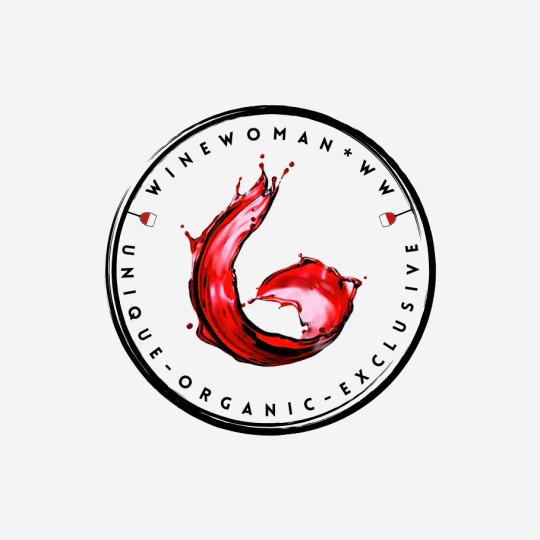
Website: https://www.winewomanww.com
Wine Woman Whisky Whisperer specializes in importing exclusive, organic European wines and Japanese whisky. With a focus on eco-friendly and sustainable practices, they offer a unique collection of wines and spirits, alongside private label wines for wholesale. Their services extend to private tastings, degustation events, and hospitality training, emphasizing their commitment to quality and environmental sustainability.
Facebook: https://www.facebook.com/Winewomanww
Instagram: https://www.instagram.com/winewomanwhiskywhisperer/
Keywords:
Japanese distilleries
Hospitality industry training
Wine tasting events
Degustation experience
Australian wine market
Biodynamic wines online
Sustainable wineries
Australian wine market trends
Biodynamic wines for sale
Eco-friendly spirits
European vineyards
Organic wine sales
Private label wine services
Sustainable winemaking practices
Wine event management
Wine event planning
eco friendly spirits
european wine importers
japanese whisky retailers
wholesale wine distribution
sustainable liquor practices
unique wine collection
quality spirits import
wine and whisky expertise
whisky tasting sessions
organic wine varieties
biodynamic wine options
sustainable spirit choices
eco conscious winemaking
imported european wines
authentic japanese whisky
custom label wine services
bulk wine distribution
engaging wine tastings
exquisite degustation experiences
training for hospitality professionals
sustainability in liquor production
rare and unique wine finds
premium spirits imports
wine and whisky connoisseurship
old world charm of european vineyards
japanese artistry in distilleries
wine event coordination
whisky tasting workshops
certified organic wine sales
environmentally friendly spirits
sustainable practices in winemaking
exclusive european wine imports
sought after japanese whiskies
custom branded wine options
wine distribution for businesses
interactive wine tastings
fine degustation experiences
professional training for hospitality
sustainability initiatives in liquor
collectible and unique wines
importing high quality spirits
expertise in wine and whisky
australian wine market insights
exploring european vineyard landscapes
japanese craftsmanship in distilling
whisky tasting masterclasses
organic wine sales online
biodynamic wine selections
eco friendly spirit choices
premier european wine imports
rare japanese whisky finds
private label wine customization
wholesale wine distribution services
exclusive wine tasting experiences
degustation events for enthusiasts
advanced hospitality industry training
liquor sustainability education
limited edition and unique wines
premium imported spirits
wine and whisky aficionado expertise
australian wine market developments
european vineyard terroir
japanese whisky distillation art
wine event coordination services
whisky tasting seminars
certified organic wine selections
biodynamic wines with character
eco conscious spirit offerings
sustainability in artisanal winemaking
european wine import insights
japanese whisky culture appreciation
custom label wine services for businesses
wine distribution partnerships
immersive wine tasting experiences
degustation events for connoisseurs
#Japanese distilleries#Hospitality industry training#Wine tasting events#Degustation experience#Australian wine market#Biodynamic wines online#Sustainable wineries#Australian wine market trends#Biodynamic wines for sale#Eco-friendly spirits#European vineyards#Organic wine sales#Private label wine services#Sustainable winemaking practices#Wine event management#Wine event planning#eco friendly spirits#european wine importers#japanese whisky retailers#wholesale wine distribution#sustainable liquor practices#unique wine collection#quality spirits import#wine and whisky expertise#whisky tasting sessions#organic wine varieties#biodynamic wine options#sustainable spirit choices#eco conscious winemaking#imported european wines
2 notes
·
View notes
Text
IoT in Action: Transforming Industries with Intelligent Connectivity

The Power of Connectivity
The Internet of Things (IoT) has become a cornerstone of innovation, as it reimagines industries and redefines the way business is conducted. In bridging the physical and digital worlds, IoT enables seamless connectivity, smarter decision-making, and unprecedented efficiency. Today, in the competitive landscape, intelligent connectivity is no longer just a technology advancement; for businesses wanting to be relevant and continue to thrive, it is now a strategic imperative.
IoT is not simply about connecting devices; it’s about creating ecosystems that work collaboratively to drive value. With industries relying heavily on real-time data and actionable insights, IoT-powered connectivity has become the backbone of operational excellence and growth. Let’s explore how this transformative technology is revolutionizing key sectors, with a focus on how businesses can leverage it effectively.
Applications of IoT in Key Industries
1.Smart Manufacturing: Efficiency Through Connectivity
Manufacturing has embraced IoT as a tool to streamline operations and boost productivity. By embedding sensors in machinery and integrating real-time monitoring systems, manufacturers can:
Predict and Prevent Downtime: IoT-enabled predictive maintenance reduces unplanned outages, saving time and money.
Optimize Resource Allocation: Smart systems track inventory, raw materials, and energy consumption, ensuring optimal usage.
Enhance Quality Control: Real-time data from production lines helps identify defects early, maintaining high-quality standards.
Example: A global automotive manufacturer integrated IoT sensors into its assembly lines, reducing equipment downtime by 25% and improving production efficiency by 30%. The ability to monitor machinery health in real time transformed their operations, delivering significant cost savings.
2.Healthcare: Improve Patient Outcomes
In healthcare, IoT has been a game-changer in enabling connected medical devices and systems that enhance patient care and operational efficiency. The main applications include:
Remote Patient Monitoring: Devices track vital signs in real time, allowing healthcare providers to offer timely interventions.
Smart Hospital Systems: IoT-enabled equipment and sensors optimize resource utilization, from patient beds to medical supplies.
Data-Driven Decisions: IoT integrates patient data across systems, providing actionable insights for personalized treatment plans.
Example: A major hospital has put into operation IoT-enabled wearables for chronic disease management. This solution reduced the number of readmissions to hospitals by 20% and empowered patients to take an active role in their health.
3.Retail: Revolutionizing Customer Experiences
IoT is revolutionizing retail through increased customer interaction and streamlined operations. Connected devices and smart analytics allow retailers to:
Personalize Shopping Experiences: IoT systems track customer preferences, offering tailored recommendations in real time.
Improve Inventory Management: Smart shelves and sensors keep stock levels optimal, reducing wastage and improving availability.
Enable Smooth Transactions: IoT-driven payment systems make checkout easier and much faster, increasing customers’ convenience
Example: A retail chain leveraged IoT to integrate smart shelves that automatically update inventory data. This reduced out-of-stock situations by 40%, improving customer satisfaction and driving higher sales.
Role of Intelligent Connectivity in Business Transformation
Intelligent connectivity lies at the heart of IoT’s transformative potential. By connecting devices, systems, and processes, businesses can:
Accelerate Decision-Making: Real-time data sharing enables faster, more informed decisions, giving companies a competitive edge.
It increases collaboration by allowing smooth communication between departments and teams, making the entire system more efficient.
Adapt to Market Dynamics: IoT enables companies to respond quickly to changes in demand, supply chain disruptions, or operational challenges.
Intelligent connectivity is not just about technology; it’s about creating value by aligning IoT solutions with business objectives. This strategic approach guarantees that IoT investments will deliver measurable outcomes, from cost savings to improved customer loyalty.
How Tudip Technologies Powers Intelligent Connectivity
Tudip Technologies specializes in designing and implementing IoT solutions that drive meaningful transformation for businesses. With a focus on innovation and collaboration, Tudip ensures that its clients achieve operational excellence through intelligent connectivity.
Tailored Solution for Every Business Industry
Tudip understands that no two businesses are alike. By customizing IoT strategies to address specific challenges, Tudip helps clients unlock the full potential of connectivity. Examples include:
Smart Supply Chains: Implementing IoT systems that provide real-time visibility into inventory and logistics, reducing delays and improving efficiency.
Energy Management: Developing IoT frameworks to monitor and optimize energy usage, driving sustainability and cost savings.
Healthcare Innovations: Designing networked medical devices that allow remote patient monitoring and data integration without a hitch.
The Future of Connected Systems
The demand for intelligent connectivity will keep increasing as the industries continue to evolve. Emerging trends in IoT include edge computing, 5G networks, and AI-powered analytics, which promise to redefine possibilities for connected ecosystems.
Businesses that embrace these advancements stand to gain:
Greater Resilience: IoT enables adaptive systems that can withstand market fluctuations and operational challenges.
Enhanced Innovation: Connected technologies open doors to new business models, revenue streams, and customer experiences.
Sustainable Growth: IoT optimizes resources and processes, contributing to long-term environmental and economic sustainability.
The future belongs to those who see connectivity not just as a technological tool but as a strategic enabler of transformation. The right partner will help businesses transform IoT from a concept into a competitive advantage.
Conclusion: Embracing Intelligent Connectivity with Tudip
IoT is not just changing the way businesses operate—it’s redefining what’s possible. From manufacturing and healthcare to retail and beyond, intelligent connectivity is driving innovation, efficiency, and growth across industries.
Tudip Technologies is at the forefront of this transformation, offering customized IoT solutions that deliver real results. By prioritizing collaboration, adaptability, and measurable outcomes, Tudip ensures that its clients stay ahead in an increasingly connected world.
Now is the time to embrace the power of IoT and unlock its potential for your business. With Tudip as your partner, the journey to intelligent connectivity is not just achievable—it’s inevitable.
Click the link below to learn more about the blog IoT in Action: Transforming Industries with Intelligent Connectivity https://tudip.com/blog-post/iot-in-action-transforming-industries-with-intelligent-connectivity/
#Tudip#IoT#intelligent connectivity#real-time data#predictive maintenance#smart manufacturing#remote patient monitoring#healthcare IoT#retail IoT#smart shelves#supply chain optimization#edge computing#AI-powered analytics#5G networks#industrial IoT#connected devices#digital transformation#operational efficiency#business intelligence#automation#data-driven decision-making#IoT solutions#smart systems#enterprise IoT#IoT-powered connectivity#sustainable growth#technology innovation#machine learning#cloud computing#smart sensors
0 notes
Text
One trusted partner, multiple sectors. Ibraniac Software has all kinds of businesses covered! https://ibraniacsoftware.com/solution/
#ibraniac#business#success#IT#ITsupport#ITsolutions#digital#sectors#businessniche#healthcare#telecom#education#media#entertainment#finance#tours#travel#hospitality#logistics#automobile#retail#manufacturing#energy#construction#realeastate#legal#sustainability#transportation
0 notes
Text
7 Reasons Why Paper Gift Bags Are Better Than Plastic Gift Bags

Looking for a sustainable packaging solution? Paper gift bags are eco-friendly, reusable, and stylish—making them a better choice than plastic. From Kraft paper bags with handles to luxury laminated designs, explore why paper bags are the best alternative for retail, gifting, and events. Learn how they contribute to sustainability, reduce waste, and comply with environmental regulations.
Blog post:- Why Are Paper Gift Bags Better Than Plastic Gift Bags?
#paper gift bags#Kraft paper bags with handles#large paper bags#eco-friendly gift bags#recyclable gift bags#sustainable packaging#paper vs plastic bags#customizable gift bags#biodegradable gift bags#luxury paper bags#eco-conscious shopping bags#paper bags for retail
0 notes
Text
E-Commerce vs. Retail: Where Sportswear Sales Are Thriving

Sportswar sales have blossomed since the last 5 years. As sports events are gaining more & more attention these days, the revenuefigures are also seeing a surge. The global events have gained recognition due to sheer love for the games. The rise of online shopping for sportswear is also seen as an upsurge due to the awareness of physical activity in people & general working class.
Understanding where sportswear sales are thriving can help manufacturers, distributors, and retailers refine their strategies, optimize supply chains, and enhance customer experiences. Whether through in-store experiences or seamless online shopping, the key to success lies in adapting to shifting market trends and technological advancements.
E-Commerce: The Powerhouse of Sportswear Sales

1. Convenience and Accessibility
E-commerce platforms have revolutionized sportswear sales by offering customers unparalleled convenience. With a few clicks, shoppers can browse a vast selection of products, compare prices, and make purchases from the comfort of their homes. The ease of access to international brands has also contributed to the sector’s exponential growth.
Moreover, digital marketplaces provide an opportunity for smaller sportswear brands to compete with established players. Direct-to-consumer (DTC) models allow brands to bypass traditional retail channels, reducing costs and increasing profit margins while maintaining full control over their branding and pricing strategies.
2. Personalization and AI-Driven Shopping Experiences
E-commerce platforms leverage AI and data analytics to personalize the shopping experience, making sportswear sales more targeted and engaging. Features such as product recommendations, virtual try-ons, and dynamic pricing enhance user satisfaction, leading to higher conversion rates.
Machine learning algorithms analyze customer behavior, enabling businesses to offer personalized discounts and promotions, further driving online sportswear sales. The use of AI-powered chatbots and virtual assistants ensures a seamless shopping journey, addressing customer queries in real time.
3. Social Commerce and Influencer Marketing
Social media platforms play a crucial role in boosting sportswear sales, with brands leveraging influencer partnerships and targeted advertising to drive engagement. Platforms like Instagram, TikTok, and Facebook have become virtual storefronts, allowing consumers to discover and purchase products without leaving the app.
Brands collaborating with athletes, fitness influencers, and celebrities generate buzz and credibility, encouraging consumers to invest in sportswear endorsed by their favorite personalities. The integration of social commerce tools further simplifies the buying process, leading to increased sales conversions.
Retail Stores: The Traditional Yet Resilient Channel

1. The In-Store Experience and Customer Engagement
Despite the rise of e-commerce, physical retail stores remain a critical avenue for sportswear sales. Many consumers still prefer to try on sports apparel and footwear before purchasing, ensuring the right fit and comfort. Retail environments also provide hands-on product demonstrations, enhancing the customer experience.
Additionally, immersive store experiences—such as Nike’s interactive concept stores—enhance customer engagement and brand loyalty. These experiential retail spaces combine technology, personalization, and community-building to differentiate physical stores from online shopping.
2. Omnichannel Strategies: The Best of Both Worlds
Successful brands integrate both retail and e-commerce by adopting an omnichannel approach to sportswear sales. Click-and-collect services, in-store digital kiosks, and virtual fitting rooms bridge the gap between online and offline shopping, offering consumers greater flexibility.
Retailers utilizing customer data from online purchases can tailor in-store experiences, ensuring personalized recommendations and promotions. This synergy enhances customer satisfaction and strengthens brand loyalty.
3. The Role of Retail in Brand Building
For many premium sportswear brands, retail stores serve as flagship destinations that reinforce brand identity. Physical spaces provide the opportunity to showcase exclusive collections, host community events, and establish a strong brand presence.
Additionally, in-store staff play a crucial role in guiding purchasing decisions, offering expert advice, and fostering a personal connection with customers. This aspect of human interaction is something e-commerce platforms struggle to replicate, giving retail stores a unique advantage.
Challenges and Opportunities in Both Channels
While both e-commerce and retail have their strengths, each comes with its own set of challenges. E-commerce businesses must tackle logistical hurdles, such as efficient shipping, returns management, and cybersecurity threats. On the other hand, brick-and-mortar stores must adapt to changing consumer preferences, rising operational costs, and the increasing demand for digital integration.
However, businesses that embrace a hybrid model can capitalize on the strengths of both platforms. For instance, brands like Adidas and Under Armour successfully integrate physical retail stores with digital tools, ensuring a seamless customer journey across multiple touchpoints.
Future Trends in Sportswear Sales

1. Sustainability and Ethical Consumerism
As consumers become more conscious of environmental impact, sustainable sportswear is gaining traction. Brands investing in eco-friendly materials, ethical production, and transparent supply chains will see a boost in sportswear sales as sustainability-driven purchasing decisions increase.
2. Augmented Reality (AR) and Virtual Shopping
The integration of AR and virtual shopping experiences is transforming how consumers interact with sportswear brands. Virtual fitting rooms, 3D product previews, and immersive brand storytelling will enhance engagement and further drive sportswear sales.
3. Subscription-Based Models and Membership Programs
Brands offering subscription services and exclusive memberships are building long-term customer relationships. Subscription-based sportswear models ensure repeat purchases and customer retention, providing a steady revenue stream.
Conclusion
The debate between e-commerce and retail in sportswear sales is not about one replacing the other but about how brands can leverage both channels effectively. While e-commerce continues to grow, retail stores remain an integral part of brand strategy, offering unique experiences that digital platforms cannot replicate.
Businesses that adopt an omnichannel approach—combining the strengths of both online and offline sales—will have the competitive edge in the evolving sportswear market. By prioritizing personalization, technology integration, and customer engagement, brands can ensure sustained growth in sportswear sales while adapting to future industry trends.
Uncover the latest trends and insights with our articles on Visionary Vogues
#Sportswear sales#e-commerce#retail trends#omnichannel strategy#AI shopping#social commerce#sustainability#AR shopping
0 notes
Text
#Retail Technology#B2B Operations#Augmented Reality#Blockchain#Artificial Intelligence#Internet of Things#Supply Chain Management#Customer Experience#Sustainability#Retail Innovation
0 notes
Text
71% of consumers want generative AI integrated into their shopping experiences
Over half (58%) of consumers have replaced traditional search engines with Gen AI tools forproduct/service recommendations, up significantly from 25% in 2023 Two-thirds of Gen Z and millennials want hyper-personalized content and product recommendations,powered by Gen AI Nearly 70% of consumers notice ads on retailer websites and apps compared to 63% on social media Poor customer experience…
0 notes
Text
Stay informed with reliable Retail News at Fashion Value Chain! Our platform delivers the latest updates on the retail industry, covering strategies, consumer trends, and significant factors impacting the market. In a constantly evolving landscape, it’s essential to stay knowledgeable about the latest developments in retail. Read our articles and reports to keep your insights fresh and relevant. Join us today for all the essential retail news!
0 notes